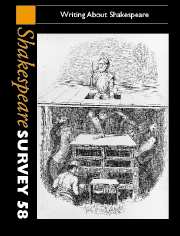Book contents
- Frontmatter
- Having Our Will: Imagination in Recent Shakespeare Biographies
- Toward a New Biography of Shakespeare
- Jonson, Shakespeare and the Exorcists
- ‘Lending soft audience to my sweet design’: Shifting Roles and Shifting Readings of Shakespeare’s ‘A Lover’s Complaint’
- ‘Armed at point exactly’: The Ghost in Hamlet
- Writing About Motive: Isabella, the Duke and Moral Authority
- Writing Performance: How to Elegize Elizabethan Actors
- Elizabeth Montagu: ‘Shakespear’s poor little Critick’?
- Rewriting Lear’s Untender Daughter: Fanny Price as a Regency Cordelia in Jane Austen’s Mansfield Park
- The Prequel as Palinode: Mary Cowden Clarke’s Girlhood of Shakespeare’s Heroines
- Shakespeare Among the Workers
- Virginia Woolf Reads Shakespeare: Or, her Silence on Master William
- Shakespeare and the Invention of the Epic Theatre: Working with Brecht
- Dramatizing the Dramatist
- Shakespeare in Drama Since 1990: Vanishing Act
- Writing about [Shakespearian] performance
- Shakespeare and the Prospect of Presentism
- Writing Shakespeare in the Global Economy
- The ‘Complexion’ of Twelfth Night
- Translation as Appropriation: Vassilis Rotas, Shakespeare and Modern Greek
- How Old Were Shakespeare’s Boy Actors?
- Mistress Tale Porter and the Triumph of Time: Slander and Old Wives’ Tales in The Winter’s Tale
- Shakespeare Performances in Ireland, 2002–2004
- Shakespeare Performances in England, 2004
- Professional Shakespeare Productions in the British Isles January–December 2003
- The Year's Contributions to Shakespearian Study 1 Critical Studies
- 2 Shakespeare in Performance
- 3 Editions and Textual Studies
- Books Received
- Index
The ‘Complexion’ of Twelfth Night
Published online by Cambridge University Press: 28 March 2007
- Frontmatter
- Having Our Will: Imagination in Recent Shakespeare Biographies
- Toward a New Biography of Shakespeare
- Jonson, Shakespeare and the Exorcists
- ‘Lending soft audience to my sweet design’: Shifting Roles and Shifting Readings of Shakespeare’s ‘A Lover’s Complaint’
- ‘Armed at point exactly’: The Ghost in Hamlet
- Writing About Motive: Isabella, the Duke and Moral Authority
- Writing Performance: How to Elegize Elizabethan Actors
- Elizabeth Montagu: ‘Shakespear’s poor little Critick’?
- Rewriting Lear’s Untender Daughter: Fanny Price as a Regency Cordelia in Jane Austen’s Mansfield Park
- The Prequel as Palinode: Mary Cowden Clarke’s Girlhood of Shakespeare’s Heroines
- Shakespeare Among the Workers
- Virginia Woolf Reads Shakespeare: Or, her Silence on Master William
- Shakespeare and the Invention of the Epic Theatre: Working with Brecht
- Dramatizing the Dramatist
- Shakespeare in Drama Since 1990: Vanishing Act
- Writing about [Shakespearian] performance
- Shakespeare and the Prospect of Presentism
- Writing Shakespeare in the Global Economy
- The ‘Complexion’ of Twelfth Night
- Translation as Appropriation: Vassilis Rotas, Shakespeare and Modern Greek
- How Old Were Shakespeare’s Boy Actors?
- Mistress Tale Porter and the Triumph of Time: Slander and Old Wives’ Tales in The Winter’s Tale
- Shakespeare Performances in Ireland, 2002–2004
- Shakespeare Performances in England, 2004
- Professional Shakespeare Productions in the British Isles January–December 2003
- The Year's Contributions to Shakespearian Study 1 Critical Studies
- 2 Shakespeare in Performance
- 3 Editions and Textual Studies
- Books Received
- Index
Summary
As a fin-de-siècle romantic comedy, Twelfth Night represents Shakespeare’s final working of the genre. The play was written and performed at the cusp of the old Elizabethan courtly and romantic comedy and the new social and satirical comedy aggressively promoted by Jonson in his second ‘humours’ play and second Globe play, Every Man Out of His Humour. It could be argued that Twelfth Night already appeared dated when it was performed at the Globe in the wake of Every Man Out in 1601. Yet that Shakespeare could hardly have been unaware of competing aesthetics and of an apparent shift in taste is evidenced in his experimentation with and dilution of both comedy in Measure for Measure and romance and the romantic in Troilus and Cressida.
The transitional nature of comedy at the turn of the century and the fierce debates about the nature and purpose of dramatic representation have been the focus of much scholarly and critical analysis. Opinions differ as to the complexion of the – now canonical – relationship between Shakespeare’s romantic comedy and what was a radical new departure on the London stage, Jonson’s ‘comical satire’. Does Twelfth Night evince exhaustion with the genre? In Twelfth Night and the subsequent darker comedies, was Shakespeare readjusting to and accommodating satire within his preferred comic forms? Or, on the contrary, was he confidently reaffirming in Twelfth Night the tropes and dynamics of romantic comedy in opposition to rival forms? Recently, contrary to earlier examinations of what has become known as the ‘poets’ war’, Jonson and Shakespeare, rather than Marston, Dekker and Jonson, have been seen as ‘rival playwrights’. In this context intertextual links between Jonson’s ‘comical satires’ and Shakespeare’s later comedies have been examined.
- Type
- Chapter
- Information
- Shakespeare Survey , pp. 199 - 207Publisher: Cambridge University PressPrint publication year: 2005
- 2
- Cited by



